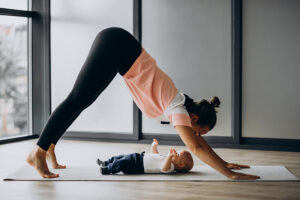Yoga is often portrayed as graceful stretching and bending into serene poses. But for those suffering from shoulder discomfort, even basic postures can seem daunting. This is where the “Gentle Warriors” come in – yoga practitioners who modify traditional poses to accommodate joint issues or limited mobility. With some adaptations, we can make yoga accessible and beneficial for all levels.
Shoulder pain is incredibly common, affecting up to 67% of adults at some point. It can originate from strained muscles, injuries, poor posture, arthritis, tendinitis, bursitis, and other conditions. Typical symptoms include soreness, stiffness, difficulty sleeping on the affected side, and reduced range of motion. Even simple activities like brushing your hair or reaching overhead may become uncomfortable.
Left untreated, shoulder problems can worsen over time and significantly impact daily life. According to health experts, American Academy of Orthopaedic Surgeons , yoga offers a low-impact way to improve flexibility, gently strengthen the muscles around the shoulder joint, and reduce discomfort. Poses can be adapted based on each student’s unique needs and current abilities. Props like blocks and straps help support the body to avoid strain or over-exertion.
When practicing yoga for shoulder pain, it’s crucial to focus on proper alignment, avoid forcing the body into poses, and work at a level that feels therapeutic rather than painful. With a few modifications, classic postures become accessible to yogis at any stage of their wellness journey. Our “Gentle Warriors” don’t need to be afraid of Downward Dog or Warrior One – with mindful form and a compassionate approach, yoga can soothe aching joints. Are you ready to give it a try?
Gentle Warriors – Top 5 Yoga Poses for Shoulder Relief
1. Downward-Facing Dog (Adho Mukha Svanasana)
The classic Downward Dog pose strengthens the entire upper body while providing a deep shoulder stretch.
To get into the pose:
– Start on all fours with hands under shoulders and knees under hips. Spread fingers wide.
– On an exhale, tuck toes under and lift knees off the floor.
– Push hips up and back, straightening legs to come into an inverted V shape.
– Ground hands firmly and rotate arms outward so elbow creases face forward.
– Relax head, neck and allow spine to lengthen.
For beginners or those with shoulder limitations:
– Bend knees deeply to take pressure off shoulders.
– Try the pose against a wall for added support.
– Use blocks under hands to elevate upper body.
Downward Dog provides multiple benefits like stretching the shoulders, upper back, hamstrings, and calves. It strengthens the arms and core. As per Yoga International, this inversion pose improves circulation and gives a gentle sense of energy.

2. Garland Pose (Malasana)
This squat pose relieves shoulder tension by stretching the upper back.
To do Garland Pose:
– From standing, separate feet slightly wider than hips. Turn toes out.
– Bend knees deeply as if sitting in a chair. Keep torso lifted.
– Bring palms together in front of chest in prayer position.
– Raise arms overhead, bending elbows with palms still together.
– Hold for 5-10 breaths then release back down.
For beginners, use a wall for balance assistance. Those with knee issues can place a rolled blanket under heels.
According to DoYogaWithMe, Garland Pose opens the shoulders and chest. The ankle stretch improves flexibility. Squatting strengthens legs and eases sciatica discomfort.

3. Standing Forward Bend (Uttanasana)
This calming forward fold stretches the entire back of the body including tight shoulders.
To do it:
– Stand with feet hip-width apart. Exhale and hinge forward from hips.
– Let arms dangle towards floor with a slight bend in knees. Relax head and neck.
– Hold pose for 8-10 breaths. Place hands on blocks to modify.
As a beginner-friendly variation, bend knees deeply to reduce hamstring strain. Those with back injuries should skip this pose.
Yoga Journal notes that Standing Forward Bend lengthens the spine and back of legs. Shoulder and upper back muscles release tension. The inversion aids circulation while calming the mind.

4. Extended Puppy Pose (Uttana Shishosana)
This gentle heart opener targets the shoulders and upper back.
To do Extended Puppy:
– Come onto hands and knees with wrists under shoulders, knees under hips.
– Walk hands forward until chest lowers toward floor. Keep hips over knees.
– Allow head to relax down with arms extended forward.
– Hold for 10 breaths then return to hands and knees.
For less intense stretching, keep hips slightly elevated and take arms wider. Avoid arching lower back excessively.
According to Yoga International, Extended Puppy Pose opens the shoulders and chest to counteract rounded posture. It progressively builds flexibility in a soothing position.

5. Supported Fish Pose (Matsyasana)
This passive backbend stretches the front of the shoulders gently with minimal strain.
To do this pose:
– Sit up on floor with legs crossed. Place a bolster or pillows lengthwise behind back.
– Gently lie back onto the support, allowing torso to relax. Arms rest alongside body.
– Remain in the pose for 5-10 breaths. To release, use core strength to lift torso back up.

For modification, reduce arch by placing blanket under upper back. Those with neck injuries should avoid this pose.
Supported Fish Pose progressively expands the chest and shoulders, according to Flexifyme. The calming inversion relieves stress and fatigue.
In summary, gentle yoga can aid shoulder pain significantly. Listen to your body, use props, and modify poses as needed for a therapeutic practice. With mindfulness and compassion, we can all be “Gentle Warriors.”
Yoga & Pain Management: Beyond the Poses
While yoga asana (poses) can provide targeted relief for shoulder discomfort, the practice offers a much broader spectrum of pain management tools. Research shows that yoga’s mind-body connection, breathing techniques (pranayama), and meditation can aid chronic pain.
According to Harvard Health, yoga may help by reducing inflammation and stress hormones like cortisol. Regular practice strengthens areas around painful joints and improves body awareness. Yoga’s meditative nature also empowers the mind to reframe its relationship with pain.
The National Center for Complementary and Integrative Health notes studies demonstrating yoga’s effectiveness for back pain, osteoarthritis, fibromyalgia, and migraine headaches. However, benefits depend on the style and intensity – gentle, adapted yoga is recommended over strenuous postures.
Mindfulness meditation helps practitioners observe physical sensations without reacting to them. This non-judgemental witnessing of pain decouples the psychological and physical aspects, reducing perceived discomfort. Beginners can try short 5-10 minute seated meditations using the breath as an anchor.
Yoga breathing exercises called pranayama help trigger the body’s relaxation response. According to Yoga Journal, slower paced breathing signals safety, lowering blood pressure, heart rate, and oxygen consumption. Techniques like alternate nostril breathing stimulate the vagus nerve to further calm the nervous system.
Beyond formal practice, yoga philosophy offers wisdom for living with discomfort. The Yoga Sutras teach that we must make peace with what we cannot control and focus our efforts on what we can change – our mental perspective, daily habits, and response to circumstances.
An integrated approach combining physical postures, breathwork, mindfulness, and lifestyle change empowers those with chronic pain. With practice over time, we can become the authors of our own wellness stories. Yoga offers tools – if we have the courage to gently explore their potential. What will your next chapter hold?
Conclusion & Beyond the Mat
In this guide, we explored how yoga can provide relief for common shoulder pain and discomfort. With some simple modifications to traditional poses, a gentle yoga practice becomes accessible to all – regardless of fitness level or mobility restrictions.
The key is listening to your body, using props for support, and moving at a pace that feels therapeutic. Poses like Downward Dog, Garland Pose, and Supported Fish progressively build flexibility while relieving tension in the joints. A compassionate, mindful approach allows anyone to experience yoga’s healing benefits.
But the practice expands far beyond physical postures. Yoga breathing, meditation, and philosophy offer additional tools for managing pain holistically. Regular practice may reduce inflammatory compounds, reframe our relationship with pain signals, and elicit the relaxation response. An integrated yoga routine becomes a powerful ally in caring for our entire being.
While this guide shares valuable insights, personalized guidance can help you safely modify yoga for your unique needs. At FlexifyMe, we connect clients with certified yoga instructors to create customized routines and modify poses based on your abilities and limitations. Our patented AI also provides real-time feedback and adjustments during virtual sessions.
Give your shoulders some TLC with a complementary intro session and start your journey towards strength, mobility, and renewed comfort.
Yoga reminds us to treat ourselves and our bodies with compassion – easing into gentle postures with care and patience. Though the path may not always be easy, yoga offers tools to find balance and contentment along the way. Our inner “Gentle Warrior” awaits!


